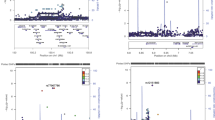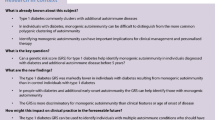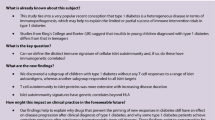Abstract
We recently developed a novel approach capable of identifying gene combinations to obtain maximal disease risk stratification. Type 1 diabetes has a preclinical phase including seroconversion to autoimmunity and subsequent progression to diabetes. Here, we applied our gene combination approach to identify combinations that contribute either to islet autoimmunity or to the progression from islet autoantibodies to diabetes onset. We examined 12 type 1 diabetes susceptibility genes (INS, ERBB3, PTPN2, IFIH1, PTPN22, KIAA0350, CD25, CTLA4, SH2B3, IL2, IL18RAP, IL10) in a cohort of children of parents with type 1 diabetes and prospectively followed from birth. The most predictive combination was subsequently applied to a smaller validation cohort. The combinations of genes only marginally contributed to the risk of developing islet autoimmunity, but could substantially modify risk of progression to diabetes in islet autoantibody-positive children. The greatest discrimination was provided by risk allele scores of five genes, INS, IFIH1, IL18RAP, CD25, and IL2 genes, which could identify 80 % of islet autoantibody-positive children who progressed to diabetes within 6 years of seroconversion and discriminate high risk (63 % within 6 years; 95 % CI 45–81 %) and low risk (11 % within 6 years; 95 % CI 0.1–22 %; p = 4 × 10−5) antibody-positive children. Risk stratification by these five genes was confirmed in a second cohort of islet autoantibody children. These findings highlight genes that may affect the rate of the beta-cell destruction process once autoimmunity has initiated and may help to identify islet autoantibody-positive subjects with rapid progression to diabetes.



Similar content being viewed by others
Abbreviations
- SNP:
-
Single-nucleotide polymorphism
- IAA:
-
Insulin autoantibodies
- GADA:
-
GAD autoantibodies
- IA-2A:
-
Islet antigen 2 autoantibodies
- ZnT8A:
-
Zinc transporter 8 autoantibodies
- AUC:
-
Area under the curve
References
Ziegler AG, Nepom GT (2010) Prediction and pathogenesis in type 1 diabetes. Immunity 32(4):468–478
Achenbach P, Bonifacio E, Ziegler AG (2005) Predicting type 1 diabetes. Curr Diabetes Rep 5(2):98–103
Bingley PJ, Gale EA (2006) Progression to type 1 diabetes in islet cell antibody-positive relatives in the European Nicotinamide Diabetes Intervention Trial: the role of additional immune, genetic and metabolic markers of risk. Diabetologia 49(5):881–890
Barrett JC, Clayton DG, Concannon P, Akolkar B, Cooper JD, Erlich HA, Julier C, Morahan G, Nerup J, Nierras C, Plagnol V, Pociot F, Schuilenburg H, Smyth DJ, Stevens H, Todd JA, Walker NM, Rich SS, Type 1 Diabetes Genetics Consortium (2009) Genome-wide association study and meta-analysis find that over 40 loci affect risk of type 1 diabetes. Nat Genet 41:703–707
Noble JA, Valdes AM, Cook M, Klitz W, Thomson G, Erlich HA (1996) The role of HLA class II genes in insulin-dependent diabetes mellitus: molecular analysis of 180 Caucasian, multiplex families. Am J Hum Genet 59:1134–1148
Todd JA (2010) Etiology of type 1 diabetes. Immunity 32:457–467
Tait BD, Colman PG, Morahan G, Marchinovska L, Dore E, Gellert S, Honeyman MC, Stephen K, Loth A (2003) HLA genes associated with autoimmunity and progression to disease in type 1 diabetes. Tissue Antigens 61:146–153
Winkler C, Lauber C, Adler K, Grallert H, Illig T, Ziegler AG, Bonifacio E (2011) An interferon-induced helicase (IFIH1) gene polymorphism associates with different rates of progression from autoimmunity to type 1 diabetes. Diabetes 60:685–690
Lempainen J, Hermann R, Veijola R, Simell O, Knip M, Ilonen J (2012) Effect of the PTPN22 and INS risk genotypes on the progression to clinical type 1 diabetes after the initiation of β-cell autoimmunity. Diabetes 61:963–966
Steck AK, Wong R, Wagner B, Johnson K, Liu E, Romanos J, Wijmenga C, Norris JM, Eisenbarth GS, Rewers MJ (2012) Effects of non-HLA gene polymorphisms on development of islet autoimmunity and type 1 diabetes in a population with high-risk HLA-DR, DQ genotypes. Diabetes 61:753–758
Winkler C, Krumsiek J, Lempainen J, Achenbach P, Grallert H, Giannopoulou E, Bunk M, Theis FJ, Bonifacio E, Ziegler AG (2012) A strategy for combining minor genetic susceptibility genes to improve prediction of disease in type 1 diabetes. Genes Immun 13(7):549–555
Ziegler AG, Hummel M, Schenker M, Bonifacio E (1999) Autoantibody appearance and risk for development of childhood diabetes in offspring of parents with type 1 diabetes: the 2-year analysis of the German BABYDIAB Study. Diabetes 48:460–468
TEDDY Study Group (2007) The environmental determinants of diabetes in the young (TEDDY) study: study design. Pediatr Diabetes 8:286–298
Schmid S, Buuck D, Knopff A, Bonifacio E, Ziegler AG (2004) BABYDIET, a feasibility study to prevent the appearance of islet autoantibodies in relatives of patients with type 1 diabetes by delaying exposure to gluten. Diabetologia 47(6):1130–1131
Hummel S, Pfluger M, Hummel M, Bonifacio E, Ziegler AG (2011) Primary dietary intervention study to reduce the risk of islet autoimmunity in children at increased risk for type 1 diabetes: the BABYDIET study. Diabetes Care 34:1301–1305
Puavilai G, Chanprasertyotin S, Sriphrapradaeng A (1999) Diagnostic criteria for diabetes mellitus and other categories of glucose intolerance: 1997 criteria by the expert committee on the diagnosis and classification of diabetes mellitus (ADA), 1998 WHO consultation criteria, and 1985 WHO criteria. World Health Organization. Diabetes Res Clin Pract 44:21–26
Achenbach P, Lampasona V, Landherr U, Koczwara K, Krause S, Grallert H, Winkler C, Pflüger M, Illig T, Bonifacio E, Ziegler AG (2009) Autoantibodies to zinc transporter 8 and SLC30A8 genotype stratify type 1 diabetes risk. Diabetologia 52:1881–1888
Törn C, Mueller PW, Schlosser M, Bonifacio E, Bingley PJ, Participating Laboratories (2008) Diabetes antibody standardization program: evaluation of assays for autoantibodies to glutamic acid decarboxylase and islet antigen-2. Diabetologia 51:846–852
Schlosser M, Mueller PW, Törn C, Bonifacio E, Bingley PJ, Participating Laboratories (2010) Diabetes antibody standardization program: evaluation of assays for insulin autoantibodies. Diabetologia 53:2611–2620
Schenker M, Hummel M, Ferber K, Walter M, Keller E, Albert ED, Janka HU, Kastendiek C, Sorger M, Louwen F, Ziegler AG (1999) Early expression and high prevalence of islet autoantibodies for DR3/4 heterozygous and DR4/4 homozygous offspring of parents with type I diabetes: the German BABYDIAB study. Diabetologia 42:671–677
Walter M, Albert E, Conrad M, Keller E, Hummel M, Ferber K, Barratt BJ, Todd JA, Ziegler AG, Bonifacio E (2003) IDDM2/insulin VNTR modifies risk conferred by IDDM1/HLA for development of type 1 diabetes and associated autoimmunity. Diabetologia 46:712–720
Fawcett T (2006) An introduction to ROC analysis. Pattern Recognit Lett 27:861–874
Clayton DG (2009) Prediction and interaction in complex disease genetics: experience in type 1 diabetes. PLoS Genet 5(7):e1000540
Ziegler AG, Rewers M, Simell O, Simell T, Lempainen J, Steck A, Winkler C, Ilonen J, Veijola R, Knip M, Bonifacio E, Eisenbarth GS (2013) Seroconversion to multiple islet autoantibodies and risk of progression to diabetes in children. JAMA 309(23):2473–2479
Howson JM, Cooper JD, Smyth DJ, Walker NM, Stevens H, She JX, Eisenbarth GS, Rewers M, Todd JA, Akolkar B, Concannon P, Erlich HA, Julier C, Morahan G, Nerup J, Nierras C, Pociot F, Rich SS, Type 1 Diabetes Genetics Consortium (2012) Evidence of gene–gene interaction and age-at-diagnosis effects in type 1 diabetes. Diabetes 61(11):3012–3017
Dendrou CA, Plagnol V, Fung E, Yang JH, Downes K, Cooper JD, Nutland S, Coleman G, Himsworth M, Hardy M, Burren O, Healy B, Walker NM, Koch K, Ouwehand WH, Bradley JR, Wareham NJ, Todd JA, Wicker LS (2009) Cell-specific protein phenotypes for the autoimmune locus IL2RA using a genotype-selectable human bioresource. Nat Genet 41(9):1011–1015
Yamanouchi J, Rainbow D, Serra P, Howlett S, Hunter K, Garner VE, Gonzalez-Munoz A, Clark J, Veijola R, Cubbon R, Chen SL, Rosa R, Cumiskey AM, Serreze DV, Gregory S, Rogers J, Lyons PA, Healy B, Smink LJ, Todd JA, Peterson LB, Wicker LS, Santamaria P (2007) Interleukin-2 gene variation impairs regulatory T cell function and causes autoimmunity. Nat Genet 39(3):329–337
Wing K, Onishi Y, Prieto-Martin P, Yamaguchi T, Miyara M, Fehervari Z, Nomura T, Sakaguchi S (2008) CTLA-4 control over Foxp3+ regulatory T cell function. Science 322(5899):271–275
Liu H, Leung BP (2006) CD4+ CD25+ regulatory T cells in health and disease. Clin Exp Pharmacol Physiol 33(5–6):519–524
Durinovic-Belló I, Wu RP, Gersuk VH, Sanda S, Shilling HG, Nepom GT (2010) Insulin gene VNTR genotype associates with frequency and phenotype of the autoimmune response to proinsulin. Genes Immun 11(2):188–193
Hermann R, Lipponen K, Kiviniemi M, Kakko T, Veijola R, Simell O, Knip M, Ilonen J (2006) Lymphoid tyrosine phosphatase (LYP/PTPN22) Arg620Trp variant regulates insulin autoimmunity and progression to type 1 diabetes. Diabetologia 49(6):1198–1208
Acknowledgments
We thank Annette Knopff, Stephanie Krause, Claudia Matzke, Marlon Scholz, Joanna Stock, for data collection and expert technical assistance; Ramona Puff for laboratory management; and Harald Grallert for performing the genotyping. We also thank all paediatricians and family doctors in Germany for participating in the BABYDIAB study. The work was supported by grants from the Kompetenznetz Diabetes mellitus (Competence Network for Diabetes mellitus) funded by the Federal Ministry of Education and Research (FKZ 01GI0805-07), the Juvenile Diabetes Research Fund (No. 17-2012-16), and funding from the German Federal Ministry of Education and Research (BMBF) to the German Center for Diabetes Research (DZD e.V.). E.B. is supported by the DFG Research Center and Cluster of Excellence—Center for Regenerative Therapies Dresden (FZ 111). Fabian Theis is funded by the European Research Council (starting grant “LatentCauses”). Jan Krumsiek is funded by the Helmholtz Postdoc Programme.
Conflict of interest
We declare that we have no conflict of interest.
Author information
Authors and Affiliations
Corresponding authors
Additional information
Communicated by Antonio Secchi.
Electronic supplementary material
Below is the link to the electronic supplementary material.
Rights and permissions
About this article
Cite this article
Bonifacio, E., Krumsiek, J., Winkler, C. et al. A strategy to find gene combinations that identify children who progress rapidly to type 1 diabetes after islet autoantibody seroconversion. Acta Diabetol 51, 403–411 (2014). https://doi.org/10.1007/s00592-013-0526-2
Received:
Accepted:
Published:
Issue Date:
DOI: https://doi.org/10.1007/s00592-013-0526-2




